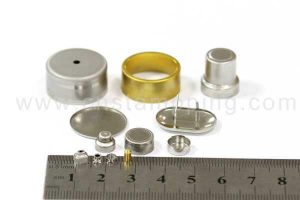Top 10 Common Sensors for IoT-SS Sensor Housings Manufacturer
Sensors are ubiquitous in IoT scenarios and are an integral part of the Internet of Things.
The first thermostat was introduced in the late 1880s, while infrared sensors have been around since the late 1940s. The Internet of Things and its counterpart, the Industrial Internet of Things (IIoT), are taking the use of sensors to a new level.
Sensors are devices that detect and respond to changes in the environment. Inputs can come from a variety of sources, such as light, temperature, motion, and pressure. Sensors output valuable information, and if they are connected to a network, they can share data with other connected devices and management systems.
Common Types of Sensors
There are many types of IoT sensors and even more applications and use cases. Here are 10 of the more popular types of IoT sensors and some of their use cases.
Temperature Sensor
Temperature sensors measure thermal energy in heat sources, enabling them to detect temperature changes and convert those changes into data.
Machinery used in the manufacturing industry often requires that the ambient and equipment temperatures be at specific levels. Similarly, within agriculture, soil temperature is a key factor in crop growth.
Humidity Sensor
Humidity sensors are used to measure the amount of water vapor in the air or other gases. They are commonly found in heating, ventilation, and air conditioning (HVAC) systems in industrial and residential areas. They can be found in many other areas, including hospitals and weather stations, to report and predict the weather.
Pressure Sensors
Pressure sensors can sense changes in gases and liquids.
When pressure changes, the sensor detects these changes and communicates them to the connected system. Common use cases include leak testing, which can be a result of attenuation. Pressure sensors are also useful in the manufacturing of water systems, as it is easy to detect fluctuations or drops in pressure.
Proximity Sensors
Proximity sensors are used for contactless detection of objects in the vicinity of the sensor. These types of sensors usually emit a beam of radiation such as electromagnetic fields or infrared. There are some interesting use cases for proximity sensors.
For example, in the retail industry, proximity sensors can detect the movement between a customer and the product they are interested in.
The user can be notified of any discounts or special offers on products located near the sensor. Proximity sensors can also be used in parking lots at malls, stadiums, and airports to indicate the availability of parking lots. They can also be used on assembly lines in chemical, food, and many other types of industries.
Liquid Level Sensors
Liquid-level sensors are used to detect the level of substances such as liquids, powders, and granular materials.
Many industries, including oil manufacturing, water treatment, beverage, and food manufacturing plants, use liquid-level sensors. Waste management systems provide a common use case, as liquid-level sensors can detect waste levels in trash cans or bins.
Accelerometers
Accelerometers detect the acceleration of an object, which is the rate at which the velocity of an object changes over time. It can also detect changes in gravity.
Examples of applications for accelerometers include smart pedometers and monitoring fleets of drivers. They can also be used as anti-theft protection, alerting the system when an object that is supposed to be stationary is moved.
Gyroscope
Gyroscope sensors measure angular rate or velocity, usually defined as measuring speed and rotation around an axis.
Use cases include automotive, such as car navigation and electronic stability control (anti-skid) systems. Other use cases include motion sensing for video games and camera shake detection systems.
Gas Sensors
These types of sensors monitor and detect changes in air quality, including the presence of toxic, flammable, or hazardous gases.
Industries that use gas sensors include mining, oil and gas, chemical research, and manufacturing. A common consumer use case is the familiar CO2 detector found in many homes.
Infrared Sensors
These types of sensors sense the characteristics of their surroundings by emitting or detecting infrared radiation. They can also measure the heat emitted by objects.
Infrared sensors are used in a variety of different IoT projects, including healthcare, as they simplify the monitoring of blood flow and blood pressure. Televisions use infrared sensors to interpret the signals sent by remote controls.
Another interesting application is that art historians use infrared sensors to see hidden layers in paintings to help determine whether a piece of art is original or fake or has been altered through a restoration process.
Optical Sensors
The Optical sensors convert light into electrical signals. Optical sensors have many applications and use cases. In the automotive industry, cars use optical sensors to identify signs, obstacles, and other things that drivers notice when driving or parking.
Optical sensors have played a big role in the development of driverless cars. Optical sensors are very common in smartphones. For example, ambient light sensors can extend battery life. Optical sensors are also used in the biomedical field, including breathing analysis and heart rate monitors.
Hejustamping-Professional Stainless Steel Sensor Housings Manufacturer

Dongguan Heju Precision Electronic Technology Co., Ltd. is a professional precision stamping parts manufacturer with 30 years of experience in customizing electronic stamping parts, such as stamped electrical terminals, spring contacts, micro deep drawn parts, automotive terminals, press fit terminals pins, contact rivets, SS sensor housings, etc. Those precision-stamped parts can be applied to micro motors, acoustic components, automotive sensors, relays, connectors, IC electrical contacts, etc. With rich stamping project experience, we can provide the best economic customized solutions for your precision project. Contact us or send drawings for your sensor housings project.
